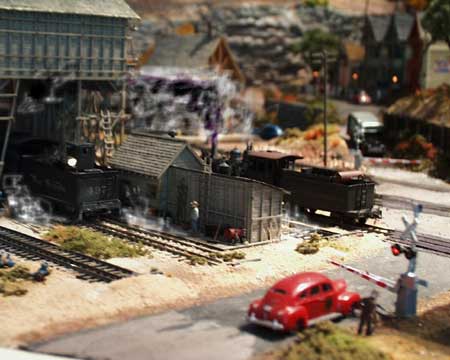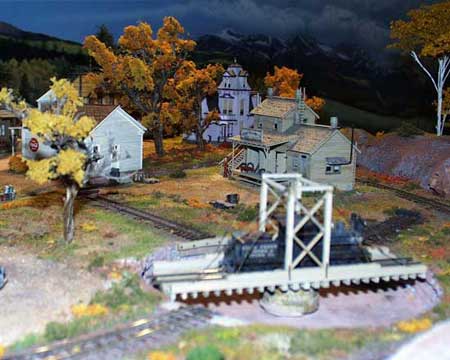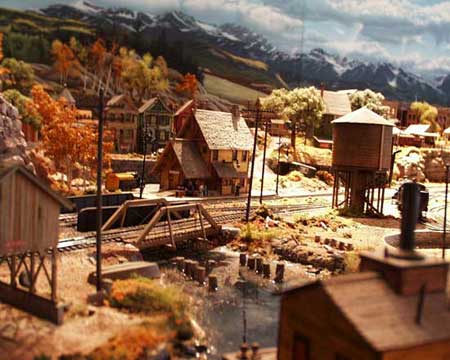The Coon Creek & Rio Grande
Colorado Narrow Gauge in the Living Room
When Ruben Aversa contacted us a little over two years ago and said; “I’d like to model Colorado in my living room on top of my entertainment center, and by the way, I want it to be 6 feet by 13 feet by 2 feet…”. Such a request it gave us a pause to say the least! We asked Ruben, who is a Miami resident to send us photos of his space, photos of structures that he had built for the layout, and we would see if we could work a miracle.
The result was the very photogenic and fun to operate Coon Creek and Rio Grande Railway Company; a little bit of Colorado in Florida.
The Scenario
Its founding brass hat was Lou Yuelich ( a modern day On3 modeller and NMRA MMR!) who sold the line’s rolling stock and locos to the current owner of the CC & RG. Most of the locomotives of the Coon Creek Logging & Mining Company were geared locos and a well preserved ex DRGW C-16 2-8-0 Consolidation. When the current owners took over the line in 1890, they embarked on an effort to provide a bridge route between distant mines which were still served by the CC & RG narrow gauge and the DRGW narrow gauge and Colorado & Southern standard gauge operations.
In this direction, by the outbreak of World War I, the entire line from Rio Grande (the interchange point and engine terminal) and Carson was dual gauged. The line’s principal stockholder and local silver king, Julius Benjamin Pittman, was credited with ban rolling the entire effort, and also for constructing the Crestview house which his heirs would eventually convert to a resort in the late 1920’s. Now the old Coon Creek line only serves the Crestview , the Crestview Brewery, and a truck transfer company that in 1930 began serving areas formerly served by the railroad (also owned by the Pittmans).
As with many roads in the early 1940’s, the CC & RG saw a dramatic upswing in traffic on its remaining trackage during World War II. Unfortunately, it also lost the last of its mine traffic and the branches were torn up for scrap for the war effort. Several of its most venerable locos also suffered the same fate as the rails. Now in 1951, the Korean conflict is still keeping the Mil l in Carson going although there are rumors of layoffs and closing of some facilities next year. Nonetheless, tourists and young newlyweds are keeping the Crestview Resort going, and the train is the most nostalgic and direct route, despite the new parking lot at the resort. The brewery boasts a very popular Bock beer that is sold as far away as Denver, and so the CC & RG takes several reefers up and down to the brewery every week. It is said that the sparkling mountain water of Coon Creek is the secret of the brew.
In addition to the brewery, resort, and the smelters around Carson, the CC & RG also serves, a box factory and iron works in Carson, a produce company at Junction, and a furniture company and coal dealer in Rio Grande. All of these businesses had a brief boom during years of World War II, but are now not providing the car loadings they once did.
The addition of gas stations and the auto and truck traffic they support are the real harbingers of the end of the CC & RG. Carson has 3 garages and even little Coon Creek supports Aversa’s which also provides service for CC & RG locos since the engine house burned before the war.
The Layout
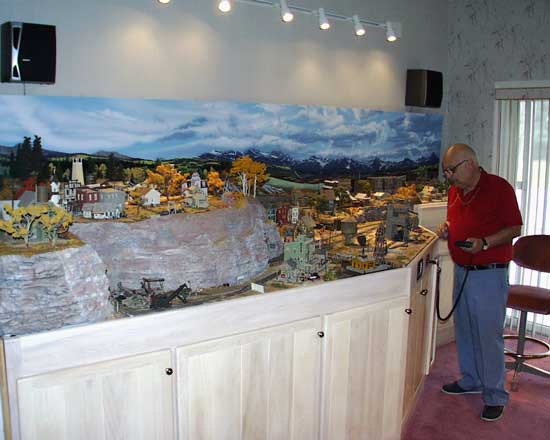
Engineer Aversa spots the sound equipped K-37 under the coal tipple at Rio Grande
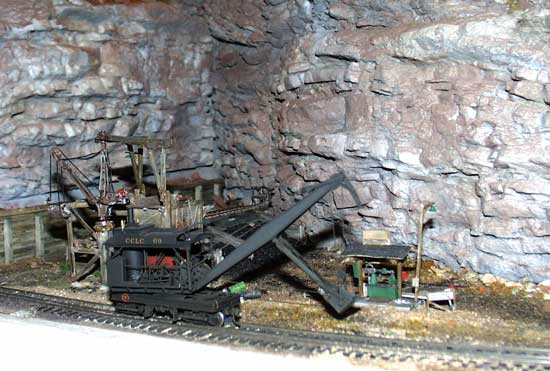
Coal for heating and industrial operations is still important despite the incursions of oil and natural gas. The railroad loaned this venarble steam shovel to the coal company to clean up a spill caused by a broken truss rod on a coal gondola.
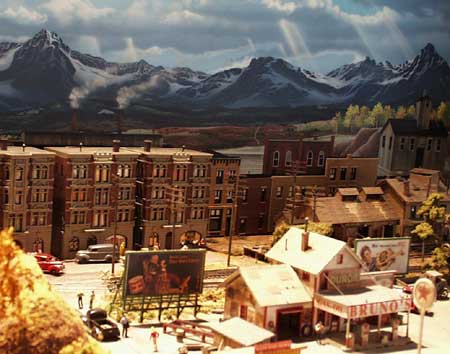
Carson bustles despite the fact that its days as a smelting center are numbered.
The layout features a sliding fiddle yard (operates like the one on Dick Wood’s GN Lincoln branch featured on this site) under Coon Creek. It has removable trays each having 3 storage tracks. All turnouts are powered by Circuitron Tortoise turnout motors.
The CC & RG is constructed of foam and 1/4″ luan plywood and set in a frame of cabinetry made of Michigan White Ash. The cabinet base includes drawers for railroad equipment and a standard DC PFM sound system, which can be used instead of the Wang row System One control system (Digital Command Control) which is housed in one of the cabinets. The cabinet also has shelves for a stereo system, a television, and two VCR’s.. The turntable in Rio Grande is scratch built and based on a dual gauge table o nce used in Denver. It is powered and indexed by a system provided by New York Railway Supply. It is the finest turntable control system ever on the market! The dual gauge track on the layout is made by Shinohara as are the turnouts, the narrow gauge trac k is from Micro-Engineering and the turnouts for HOn3 in Coon Creek are by BK Enterprises.
In places where there is large amounts of foam to penetrate a rod and tube linkage is used to activate the turnout points with the stall motors from Circuitron.
All structures are lit and all street lights also are illuminated. Crossing signals by FX Express include sound and several locos include Soundtraxx DCC sound decoders.
In order to extend the run from Rio Grande to Carson, there is a 36″ radius 2 turn helix hidden under Coon Creek. The part of Coon Creek over the center of the helix is removable, exposing a comfortable pop-up for service and even operation. This pop-up is accessed through a large door on the front of the cabinet. With the addition of this access there is no part of the layout out of reach despite its 6 foot depth.

